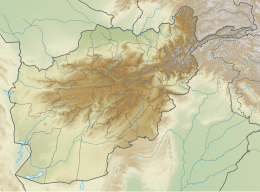
Maidan Wardak, also called Wardag or Wardak, is one of the 34 provinces of Afghanistan, located in the central region of Afghanistan. It is divided into eight districts and has a population of approximately 500,000. The capital of the province is Maidan Shar, while the most populous district in the province is Saydabad District. Wardak is known for one of its famous high peak mountain known as.
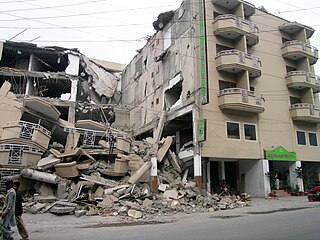
An earthquake occurred at on 8 October in Azad Kashmir. It was centred near the city of Muzaffarabad, and also affected nearby Balakot in Khyber Pakhtunkhwa and some areas of Jammu and Kashmir. It registered a moment magnitude of 7.6 and had a maximum Mercalli intensity of XI (Extreme). The earthquake was also felt in Afghanistan, Tajikistan, India, and the Xinjiang region. The severity of the damage caused by the earthquake is attributed to severe upthrust. Over 86,000 people died, a similar number were injured, and millions were displaced. It is considered the deadliest earthquake in South Asia, surpassing the 1935 Quetta earthquake.
The February 1998 Afghanistan earthquake occurred at near the Afghanistan-Tajikistan border. The strike-slip shock had a moment magnitude of 5.9 and a maximum Mercalli intensity of VII. With several thousand dead and hundreds injured, the event's effects were considered extreme by the National Geophysical Data Center. It was felt at Tashkent and Dushanbe, and aftershocks continued for the next seven days.
The 2003 Boumerdès earthquake occurred on May 21 at in northern Algeria. The shock had a moment magnitude of 6.8 and a maximum Mercalli intensity of X (Extreme). The epicentre of the earthquake was located near the town of Thénia in Boumerdès Province, approximately 60 km east of the capital Algiers. The quake was the strongest to hit Algeria in more than twenty years – since 1980, when a magnitude 7.1 earthquake resulted in at least 2,633 deaths.
The 2002 Bou'in-Zahra earthquake occurred on 22 June 2002. The epicenter was near the city of Bou'in-Zahra in Qazvin Province, a region of northwestern Iran which is crossed by several major faults that is known for destructive earthquakes. The shock measured 6.5 on the scale, had a maximum Mercalli intensity of VIII (Severe), and was followed by more than 20 aftershocks. At least 230 people were killed and 1,500 more were injured.
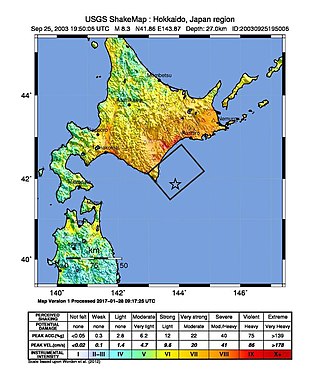
The 2003 Hokkaidō earthquake, scientifically named the 2003 Tokachi-Oki earthquake, occurred off the coast of Hokkaidō, Japan on 26 September at 04:50 local time. At a focal depth of 27 km (17 mi), this great undersea earthquake measured 8.3 on the moment magnitude scale, making it the most powerful earthquake of 2003, as well as one of the most intense earthquakes to hit Japan since modern record-keeping began in 1900.
The 2011 Sikkim earthquake occurred with a moment magnitude of 6.9 and was centered within the Kanchenjunga Conservation Area, near the border of Nepal and the Indian state of Sikkim, at on Sunday, 18 September. The earthquake was felt across northeastern India, Nepal, Bhutan, Bangladesh and southern Tibet.

The October 2015 Hindu Kush earthquake was a magnitude 7.5 earthquake that struck South Asia on 26 October 2015, at 13:39 AFT with the epicenter 45 km north of Kuran wa Munjan, Afghanistan, at a depth of 212.5 km.

On 12 November 2017 at 18:18 UTC, an earthquake with a moment magnitude of 7.3 occurred on the Iran–Iraq border, with the Iraqi Kurdish city of Halabja, and the Kurdish dominated places of Ezgeleh, Salas-e Babajani County, Kermanshah Province in Iran, closest to the epicentre, 30 kilometres (19 mi) south of the city of Halabja, Iraqi Kurdistan.
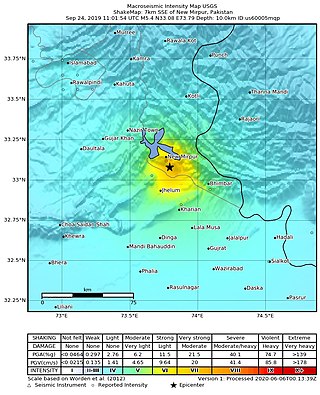
The 2019 Kashmir earthquake struck regions of Pakistan with an epicentre in Azad Kashmir on 24 September at 16:02 local time. It had a magnitude of 5.4 and a maximum felt intensity of VII on the Modified Mercalli scale. There was severe damage in Mirpur District, causing the deaths of 40 people and injuring a further 850. The epicentre of the shallow quake was near the city of Mirpur, Pakistan. The tremors were felt in the Kashmir region, Punjab (Pakistan), Punjab (India), Uttarakhand and northern parts of India including New Delhi.

The 2020 Elazığ earthquake occurred at 20:55 local time on 24 January in Turkey. The magnitude of the earthquake was determined to be 6.7 . The earthquake's epicentre was close to the town of Sivrice in Elazığ Province and felt in the neighbouring provinces of Diyarbakır, Malatya and Adıyaman, and the neighbouring countries of Armenia, Syria and Iran. Kandilli Observatory reported the magnitude of the earthquake as 6.5 Mw . A total of 41 people were killed and more than 1,600 were injured.
A series of flash floods occurred in Afghanistan beginning in June 2020, with the largest and most impactful flood occurring on 26 August 2020. They were caused by torrential rain in Charikar, Parwan Province. The August floods killed at least 179 people and injured 212 others, and destroyed hundreds of houses. The Ministry of Disaster Management has also reported some casualties and destruction of infrastructure in the provinces of Kapisa, Maidan Wardak, Nangarhar, Panjshir, and Paktia.
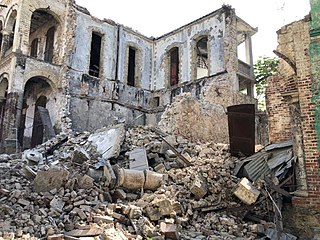
At 08:29:09 EDT on 14 August 2021, a magnitude 7.2 earthquake struck the Tiburon Peninsula in the Caribbean nation of Haiti. It had a 10-kilometre-deep (6.2 mi) hypocenter near Petit-Trou-de-Nippes, approximately 150 kilometres (93 mi) west of the capital, Port-au-Prince. Tsunami warnings were briefly issued for the Haitian coast. At least 2,248 people were confirmed killed as of 1 September 2021 and more than 12,200 injured, mostly in the Sud Department. An estimated 650,000 people were in need of assistance. At least 137,500 buildings were damaged or destroyed.
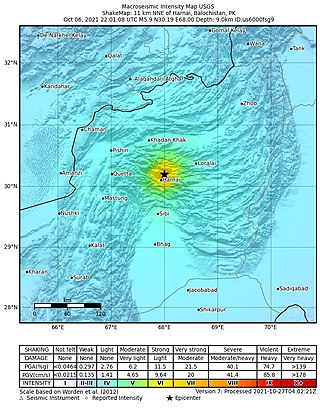
An earthquake struck Pakistan's province of Balochistan near the city of Harnai on 7 October 2021. The moment magnitude 5.9 Mww quake struck in the early morning at 03:01 local time, killing at least 42 people and injuring 300 others. The earthquake occurred just one day before the anniversary of the 2005 Kashmir earthquake.
Events in the year 2022 in Afghanistan.
An earthquake measuring Mw 4.9, followed by a 5.3 Mw mainshock struck Badghis Province, Afghanistan, on January 17, 2022. The earthquake led to a large number of casualties for the tremor's magnitude, with 30 dead and 49 injured. The earthquake destroyed hundreds of homes in northwestern Afghanistan.

A 4.0-kilometre (2.5 mi) deep earthquake measuring magnitude (Mw ) 6.2 struck southeastern Afghanistan on 22 June 2022 at 01:24:36 AFT. It affected the provinces of Paktika and Khost, and parts of Khyber Pakhtunkhwa, Pakistan. It was felt over 500 km (310 mi) away by at least 119 million people, including in Pakistan's Punjab and in parts of India and Iran. According to the United States Geological Survey (USGS), the earthquake had a maximum Modified Mercalli intensity of VIII (Severe).

On July 27, 2022, at 8:43:24 a.m. (PHT), an earthquake struck the island of Luzon in the Philippines. The earthquake had a magnitude of 7.0 Mw , with an epicenter in Abra province. Eleven people were reported dead and 615 were injured. At least 35,798 homes, schools and other buildings were damaged or destroyed, resulting in ₱1.88 billion (US$34 million) worth of damage.
On 11 September 2022, an earthquake of moment magnitude 7.6–7.7 struck Papua New Guinea, in the northern part of Morobe Province. The normal faulting earthquake occurred with a hypocenter depth of 116.0 km (72.1 mi) beneath the Finisterre Range. A maximum perceived Modified Mercalli intensity of VIII (Severe) was estimated. Shaking was widely felt across the country and even in neighbouring Indonesia. At least 21 people died and 42 were injured, mostly due to landslides.
